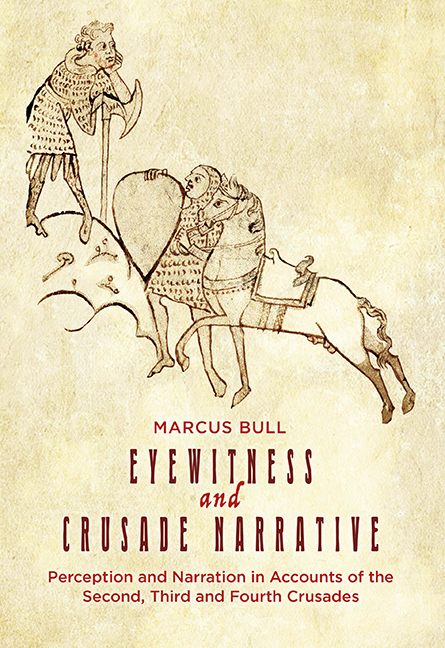 Eyewitness and Crusade Narrative
Eyewitness and Crusade Narrative Book contents
- Frontmatter
- Dedication
- Contents
- Acknowledgements
- Abbreviations
- Introduction: Medieval and Modern Approaches to Eyewitnessing and Narratology as an Analytical Tool
- 1 Memory and Psychological Research into Eyewitnessing
- 2 The Second Crusade: The De Expugnatione Lyxbonensi and Odo of Deuil's De Profectione Ludovici VII in Orientem
- 3 The Third Crusade: Ambroise's Estoire de la Guerre Sainte and Points of Comparison and Contrast
- 4 Geoffrey of Villehardouin's and Robert of Clari's Narratives of the Fourth Crusade
- Conclusion
- Bibliography
- Index
Introduction: Medieval and Modern Approaches to Eyewitnessing and Narratology as an Analytical Tool
Published online by Cambridge University Press: 12 February 2019
- Frontmatter
- Dedication
- Contents
- Acknowledgements
- Abbreviations
- Introduction: Medieval and Modern Approaches to Eyewitnessing and Narratology as an Analytical Tool
- 1 Memory and Psychological Research into Eyewitnessing
- 2 The Second Crusade: The De Expugnatione Lyxbonensi and Odo of Deuil's De Profectione Ludovici VII in Orientem
- 3 The Third Crusade: Ambroise's Estoire de la Guerre Sainte and Points of Comparison and Contrast
- 4 Geoffrey of Villehardouin's and Robert of Clari's Narratives of the Fourth Crusade
- Conclusion
- Bibliography
- Index
Summary
There is a category of historical evidence that historians are wont to characterize, and indeed to essentialize, as ‘eyewitness’. This is not just a technical term of art. The idea of being an eyewitness to something is deeply embedded in a wide range of cultural situations. We do not need to have a formal grounding in common law, for instance, to appreciate that the reliability of a witness who claims to have seen an event is normally greater than that of someone who is merely passing on hearsay. As is discussed in more detail below, sight and light are the basis of countless metaphors for understanding, realization and many other cognitive operations. So when we say that a historical source is ‘eyewitness’, we are making very large claims about it, even though the underlying assumptions about what we are saying have been surprisingly little studied relative to the importance of this category to the ways in which historians evaluate and deploy their evidence. All historical evidence that is the result or residue of human agency – as opposed to, say, tree-ring data and some types of archaeological deposit – has some experiential basis. But the particular appeal of eyewitness evidence is that, all other things being equal, it seems to close the gap between record and experience more than any other trace of the human past. It is through eyewitness evidence that we seem to get closest to validating the powerful instinct that people in the past must have led lives grounded in moment-by-moment sensory experience that was every bit as real to them as our lived experience is to us. In this way the category of eyewitness evidence seems to plug historical inquiry into basic human capacities that transcend cultural differences across time and space – or at least do so enough to grant us a meaningful point of entry into societies which in many respects can strike us as very dissimilar from our own. Eyewitnessing appears to be a powerful common denominator that permits us to understand and empathize with people in the past.
- Type
- Chapter
- Information
- Eyewitness and Crusade NarrativePerception and Narration in Accounts of the Second, Third and Fourth Crusades, pp. 1 - 71Publisher: Boydell & BrewerPrint publication year: 2018


